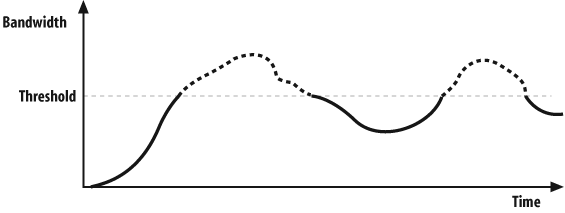Storm Control
Storm control prevents broadcast, multicast, and unicast storms from overwhelming a network. Storms can be the result of a number of issues, from bridging loops to virus outbreaks. With storm control, you can limit the amount of storm traffic that can come into a switch port. Outbound traffic is not limited.
With storm control enabled, the switch monitors the packets coming into the configured interface. It determines the amount of unicast, multicast, or broadcast traffic every 200 milliseconds, then compares that amount with a configured threshold. Packets that exceed the threshold are dropped.
This sounds straightforward, but the feature actually works differently from how many people expect. When I first learned of it, I assumed that the preceding description was accurateâthat is, that at any given time, traffic of the type I'd configured for monitoring would be allowed to come into the switch until the threshold was met (similar to what is shown in Figure 18-1). The reality, however, is more complicated.

Figure 18-1. Incorrect storm-control model
In reality, the switch monitors the interface, accumulating statistics in 200 ms increments. If, at the end of 200 ms, the threshold has been exceeded, the configured (or default) action is taken for the next 200 ms increment.
Figure 18-2 shows how storm-control actually functions. Traffic is measured in 200 ms increments, ...
Get Network Warrior now with the O’Reilly learning platform.
O’Reilly members experience books, live events, courses curated by job role, and more from O’Reilly and nearly 200 top publishers.

